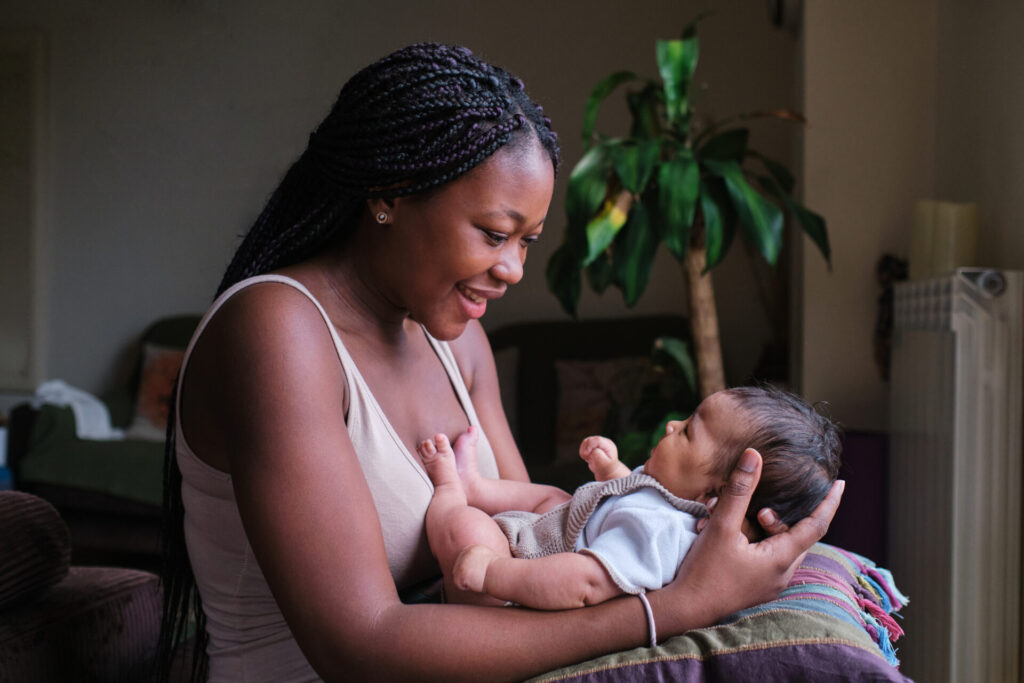Dana Glessner laughs as a visitor admires the vivid artwork clipped to a clothesline in her kitchen. The prolific artist is her four-year-old son Clay. A picture flashes onto her computer, and there is Clay. His shock of red hair gleams in the sun. His impish smile hints at his confidence. This is a happy family home. But for Dana, someone is missing.
“I feel like we’re not yet a real family, not a complete family because there’s only one child.”
Dana is one of more than three million women in North America dealing with secondary infertility—that is, women who have conceived one or more children, but suddenly can’t get pregnant again. It’s a shock for Dana, who always imagined she’d have four or five kids and got pregnant with Clay after just a month of being off birth control. But when they tried again, nothing seemed to work. They went to a fertility doctor when Dana was just 28 years old. She’s now 31, and the doctor has no explanation. “Every appointment I feel like he says the same thing to me,” Dana says. “‘Your prognosis is great, you’ve had a baby before’.” Most doctors would agree with that assessment. Statistically, 85 percent of people who’ve been pregnant once can get pregnant again.
The Glessners know that 85 percent figure. But they have other numbers in their life —$11,000 spent in fertility treatments; three years of needles, drugs and procedures; three pregnancies; three miscarriages—including one that is still a medical mystery. It came during her first round of in vitro fertilization. The blood tests confirmed she was pregnant. The due date was set. But during her six-week ultrasound, her doctor said she had a blighted ovum, a condition which fools the body into thinking it’s pregnant. You develop all symptoms and hormones that accompany pregnancy. But a fetus never forms. With that devastating news, Dana waited for the miscarriage to begin. It didn’t. So a week later, her doctor did another ultrasound. “And he said, ‘there’s an eight-week-old baby in here! And it has the perfect heartbeat, and the perfect size! Never in my career has this happened. I don’t know how I missed it!’ So, it’s a miracle.” The baby’s heartbeat stopped two weeks later.
Why No Second?
There are some common causes for secondary infertility: the age of one or both parents, ovulation problems, endometriosis, fibroids in the uterus. But then there are patients like Dana, where there doesn’t seem to be an explanation. “They are the really sad ones,” says Dr. Timothy Rowe, the head of the Division of Reproductive Endocrinology and Infertility at the University of British Columbia. “They’re the ones that tax us because we don’t have a good explanation. I still have this perception that something happens during delivery (of the first child) that’s made a difference, because what else has changed? The only thing that’s happened is that the uterus has swelled up and gone down again.” In Dr. Rowe’s experience, couples facing secondary infertility are somewhat calmer than couples still trying for baby number one. “You don’t see the panic-stricken look in people’s faces,” he says. “You don’t see the haunted expression in the eyes. They know that it’s worked once. Even subconsciously I find myself relaxing a bit because I find myself thinking about that 85 percent figure.”
Sherry Dale, a fertility counsellor in Toronto, says that may be true, but there is a unique angst for couples dealing with secondary infertility. “People don’t really get it, especially people who are dealing with primary fertility issues. Couples who can’t have even one child might say, or imply, ‘You should be happy with what you’ve got and not be greedy’,” she says. Even Dana doesn’t completely understand her need for a second child. “I have times when I feel guilty, when I think ‘he’s not enough for me, I’m not satisfied with just him.’ I feel bad about that.”
Sherry urges Dana to give herself a break. “A lot of the work that we do with secondary infertility clients is helping them to realize that they’re entitled to want what they want, that they don’t have to apologize to anybody, or justify it to anybody.”
Well-Meaning Friends
There are all the ‘helpful’ hints and advice that almost all fertility patients hear from well meaning family and friends—suggestions that the couple “just relax” or try various medical solutions. “I like hearing other people’s stories,” says Dana, but when they urge me to try this vitamin or herb or Chinese medicine, it just makes me feel as if they’re really saying ‘It isn’t happening for you because you’re doing something wrong, and if you just find the magic variable and plug it into the equation then you’ll have a baby’. So you’re on this never-ending search for the magic variable because there’s never been an explanation for our fertility issues.” It’s an uncomfortable situation for many patients. How do you tell people that those comments don’t help? Sherry says it’s best to acknowledge the awkwardness of it all.
“I encourage people to say okay, we’re going into this treatment, and while we’re in it, what would really be helpful for us is if you would say this and do that.” Be specific about what will help. Some fertility clinics print up a list of dos and don’ts for clients to hand out to members of their support network. Some come from fertility patients themselves, and include unwanted comments such as:
- Try to look on the bright side
- Well, you already have one
- If you really want kids, take mine for a weekend.
Adoption is another touchy subject for many couples, with the common sentiment being they should “give a home to a child who needs one” rather than trying to conceive another baby. Dana says she’s open to the idea, but not yet. “I think because I had such a positive experience the first time. I loved being pregnant, I loved giving birth, I loved breast-feeding, I loved it all. And I love seeing my husband and I together in Clay – things that he does that makes me say ‘Oh, that’s so you’.” If Clay is like his dad, he will be a patient, understanding man. Dana readily admits this urgent desire for their own child is far more her dream than her husband Justin’s. That’s pretty normal, says Sherry. “In my experience women are more likely to have a sense in their mind of what their family looks like. And if their family always looked like them, their partner and three kids, and they have two kids, then somebody’s missing. Whereas a man is more likely to feel like once he’s a father, he’s a father and it’s not as critical for him whether he’s the father of one or three or five.” Dale says a man might often feel more upset by his wife’s distress during failed fertility treatments, than at the lack of success in getting pregnant.
Surrounded By Kids
As a mom, women like Dana are often immersed in the world of children. At the library. At the swimming pool. At the play group. And often there
are other moms with burgeoning bellies talking cheerfully about the second child on the way. Sherry Dale says fertility patients who find themselves in that place, and have a tough time coping with it, should develop escape plans. “If you’re at a birthday party and you feel as if you’re going to melt down, then you need to get out of there. Whether that means going to the party with another mom who can drive your kid home afterwards, or having a partner who can come and spell you off. Lots of times just knowing you have that escape hatch means that you don’t need it.”
For Dana Glessner, every birthday is painful. When it’s hers, it means she’s one year older, and her fertility rate falls. When it’s Clay’s birthday, it’s a reminder of the growing age gap between him and his potential sibling… one more year she feels she’s “dooming him to a lifetime of loneliness and self-centeredness” as an only child. Still, despite all the tests, the needles, the cost, the tears, Dana says she gets “glimpses of good” that have come with the pain of these past years that put things into perspective. “I’ve lived a kind of charmed life. Everything I’ve wanted I’ve gotten. Finished my
masters degree at 23, got married when I was 23. Everything has just come my way. I felt called to be in the mental health profession, and you know, I never had the experience of suffering and grief and loss. Until now.”
Kelly Ryan’s second and third children were conceived through in vitro fertilization. She lives and writes in Vancouver, B.C. Originally published in 2010.















